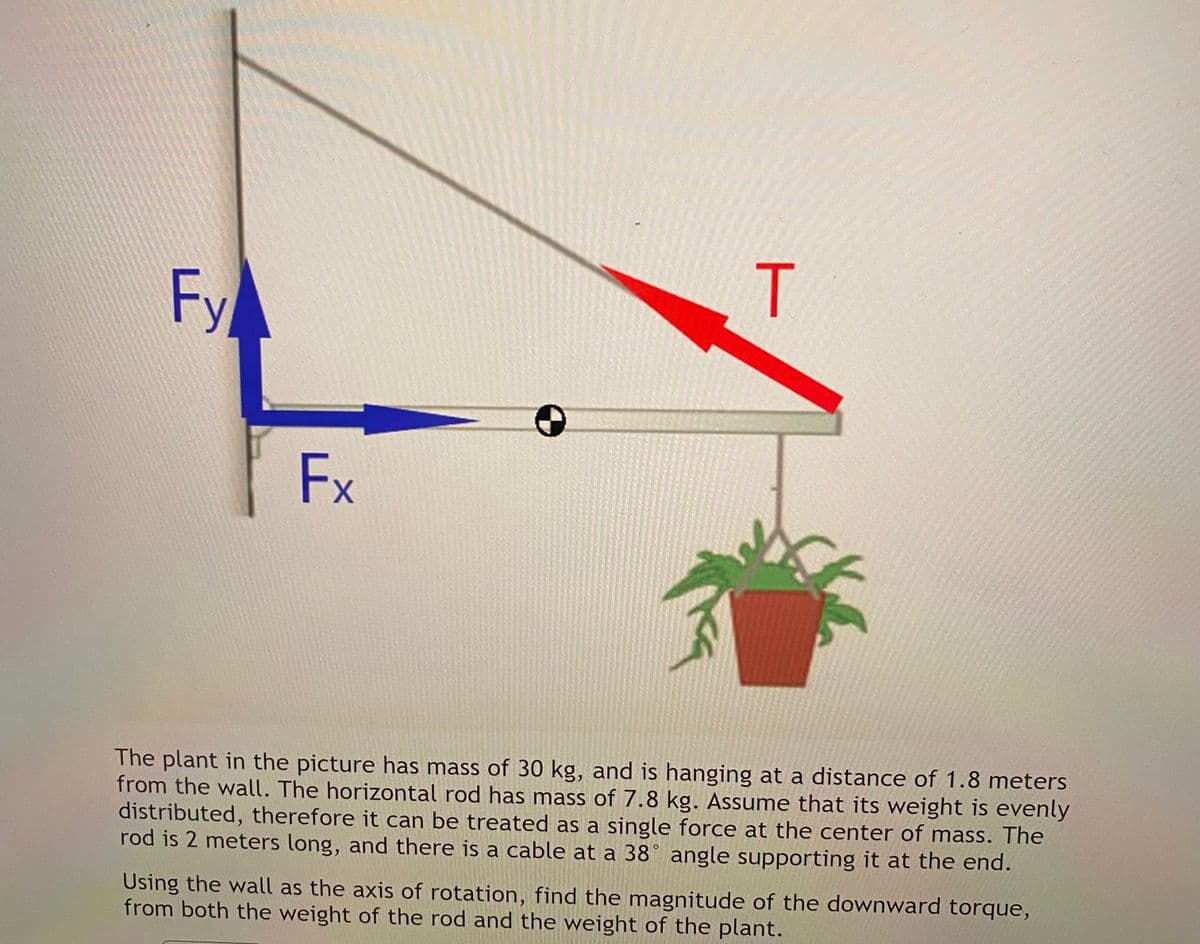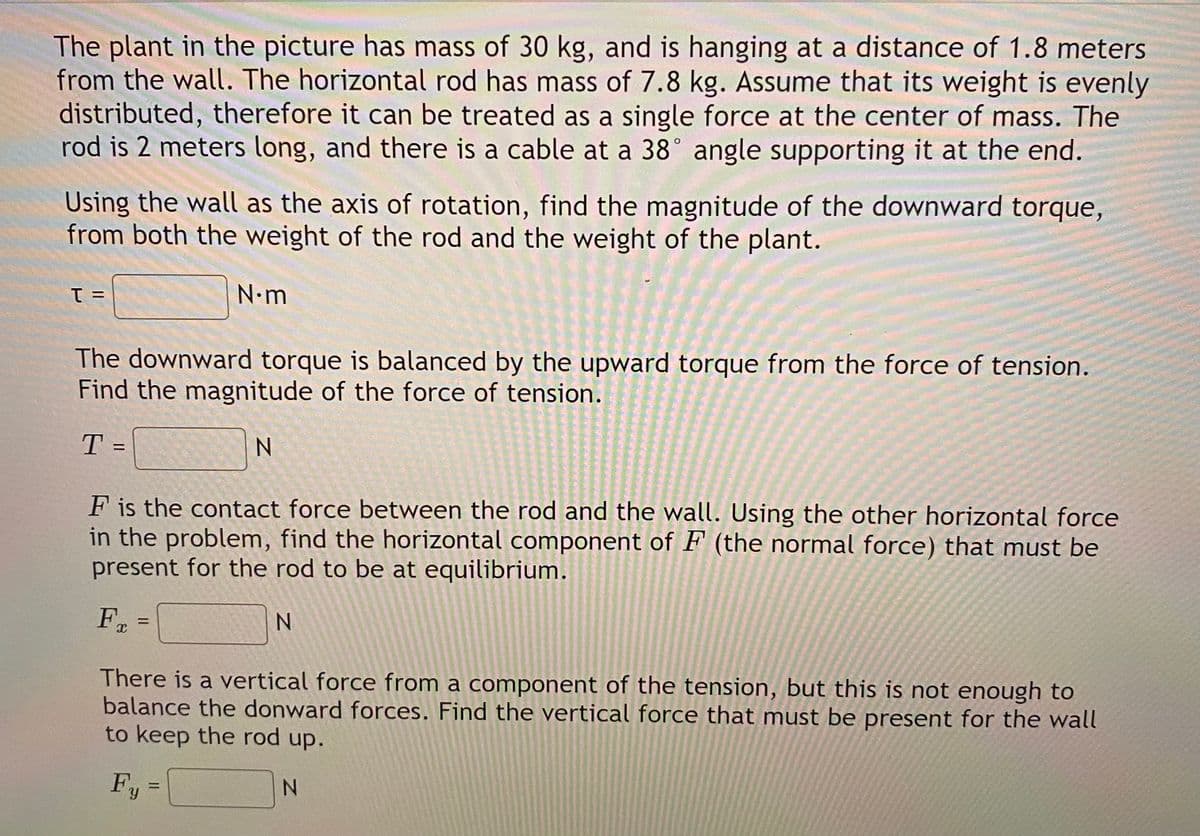The plant in the picture has mass of 30 kg, and is hanging at a distance of 1.8 meters from the wall. The horizontal rod has mass of 7.8 kg. Assume that its weight is evenly distributed, therefore it can be treated as a single force at the center of mass. The rod is 2 meters long, and there is a cable at a 38° angle supporting it at the end. Using the wall as the axis of rotation, find the magnitude of the downward torque, from both the weight of the rod and the weight of the plant. N.m The downward torque is balanced by the upward torque from the force of tension. Find the magnitude of the force of tension. T = F is the contact force between the rod and the wall. Using the other horizontal force in the problem, find the horizontal component of F (the normal force) that must be present for the rod to be at equilibrium. N. %3D There is a vertical force from a component of the tension, but this is not enough to balance the donward forces. Find the vertical force that must be present for the wall to keep the rod up. Fy = %3D
The plant in the picture has mass of 30 kg, and is hanging at a distance of 1.8 meters from the wall. The horizontal rod has mass of 7.8 kg. Assume that its weight is evenly distributed, therefore it can be treated as a single force at the center of mass. The rod is 2 meters long, and there is a cable at a 38° angle supporting it at the end. Using the wall as the axis of rotation, find the magnitude of the downward torque, from both the weight of the rod and the weight of the plant. N.m The downward torque is balanced by the upward torque from the force of tension. Find the magnitude of the force of tension. T = F is the contact force between the rod and the wall. Using the other horizontal force in the problem, find the horizontal component of F (the normal force) that must be present for the rod to be at equilibrium. N. %3D There is a vertical force from a component of the tension, but this is not enough to balance the donward forces. Find the vertical force that must be present for the wall to keep the rod up. Fy = %3D
Principles of Physics: A Calculus-Based Text
5th Edition
ISBN:9781133104261
Author:Raymond A. Serway, John W. Jewett
Publisher:Raymond A. Serway, John W. Jewett
Chapter10: Rotational Motion
Section: Chapter Questions
Problem 14OQ: A rod 7.0 m long is pivoted at a point 2.0 m from the left end. A downward force of 50 N acts at the...
Related questions
Question
100%

Transcribed Image Text:Fy
Ex
The plant in the picture has mass of 30 kg, and is hanging at a distance of 1.8 meters
from the wall. The horizontal rod has mass of 7.8 kg. Assume that its weight is evenly
distributed, therefore it can be treated as a single force at the center of mass. The
rod is 2 meters long, and there is a cable at a 38° angle supporting it at the end.
Using the wall as the axis of rotation, find the magnitude of the downward torque,
from both the weight of the rod and the weight of the plant.

Transcribed Image Text:The plant in the picture has mass of 30 kg, and is hanging at a distance of 1.8 meters
from the wall. The horizontal rod has mass of 7.8 kg. Assume that its weight is evenly
distributed, therefore it can be treated as a single force at the center of mass. The
rod is 2 meters long, and there is a cable at a 38° angle supporting it at the end.
Using the wall as the axis of rotation, find the magnitude of the downward torque,
from both the weight of the rod and the weight of the plant.
N.m
The downward torque is balanced by the upward torque from the force of tension.
Find the magnitude of the force of tension.
T =
N.
%3D
F is the contact force between the rod and the wall. Using the other horizontal force
in the problem, find the horizontal component of F (the normal force) that must be
present for the rod to be at equilibrium.
N.
There is a vertical force from a component of the tension, but this is not enough to
balance the donward forces. Find the vertical force that must be present for the wall
to keep the rod up.
Fy=
N.
%3D
Expert Solution
This question has been solved!
Explore an expertly crafted, step-by-step solution for a thorough understanding of key concepts.
This is a popular solution!
Trending now
This is a popular solution!
Step by step
Solved in 2 steps with 5 images

Knowledge Booster
Learn more about
Need a deep-dive on the concept behind this application? Look no further. Learn more about this topic, physics and related others by exploring similar questions and additional content below.Recommended textbooks for you

Principles of Physics: A Calculus-Based Text
Physics
ISBN:
9781133104261
Author:
Raymond A. Serway, John W. Jewett
Publisher:
Cengage Learning

Physics for Scientists and Engineers, Technology …
Physics
ISBN:
9781305116399
Author:
Raymond A. Serway, John W. Jewett
Publisher:
Cengage Learning

Physics for Scientists and Engineers: Foundations…
Physics
ISBN:
9781133939146
Author:
Katz, Debora M.
Publisher:
Cengage Learning

Principles of Physics: A Calculus-Based Text
Physics
ISBN:
9781133104261
Author:
Raymond A. Serway, John W. Jewett
Publisher:
Cengage Learning

Physics for Scientists and Engineers, Technology …
Physics
ISBN:
9781305116399
Author:
Raymond A. Serway, John W. Jewett
Publisher:
Cengage Learning

Physics for Scientists and Engineers: Foundations…
Physics
ISBN:
9781133939146
Author:
Katz, Debora M.
Publisher:
Cengage Learning

University Physics Volume 1
Physics
ISBN:
9781938168277
Author:
William Moebs, Samuel J. Ling, Jeff Sanny
Publisher:
OpenStax - Rice University

Glencoe Physics: Principles and Problems, Student…
Physics
ISBN:
9780078807213
Author:
Paul W. Zitzewitz
Publisher:
Glencoe/McGraw-Hill